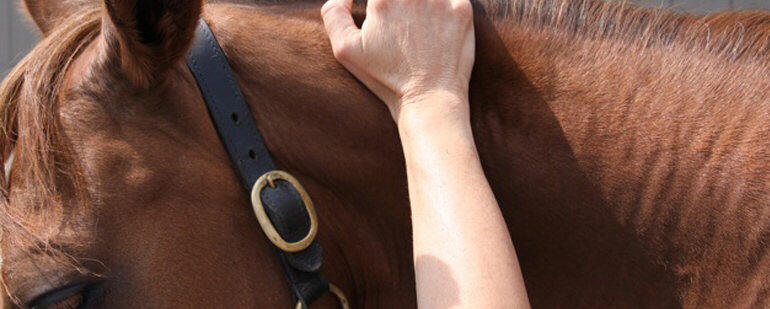|
CASE STUDY: MOTION PROBLEM, CAUSE AND SOLUTION - SUMMER 2012
Problem: Stiff in hind legs. Loss of power
at all gaits. Diminished response to leg aids.
Jane was pleased with her new saddle since the
old one seemed to have pinched her horse’s back. She knew the old saddle
was causing back discomfort because her horse traveled with his head
high and a hollow back with an unwillingness to go forward. Now that
she had been using the new saddle, her horse was traveling better, but
she still felt he was short in the hind end and was not as responsive
to her leg aid.
Jane called me three weeks after riding in her
new saddle. She originally thought the motion problems she was experiencing
were residual problems from her old ill fitting saddle. But three weeks
after riding in her new saddle, she thought she had cause for concern.
When I arrived at the barn, Jane asked if I thought
the new saddle could be causing the shortened stride and back discomfort.
She was very worried because she spent a good amount of money on her
new saddle. I reassured her that if the problem was of a muscular nature,
we would be able to determine the cause and eliminate the problem by
using the Wilson Meagher Method of Sportsmassage.
Assessment:
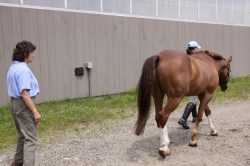 I
asked Jane to walk the horse in a straight line away from me and then
toward me. I get the best view of muscular function at the walk. The
slower the movement, the more muscle is used. The horse seemed short
in both hind legs and walked quite stiff from behind. We brought the
horse in the stall and I gently palpated his back with the flat of my
hand. His lower back was slightly tight. His left and right gluteal
muscles, which are called the rump, were quite tight, especially where
they meet the back muscle up at the croup (sacrum). The two left and
right gluteal muscles I palpated extend the hip and in conjunction with
the back muscles are the main source of forward motion and power for
cantering, galloping, jumping and collected work. The names of the two
muscles are the gluteus medius and gluteal accessorius. If they are
tight, I find that they may refer their tightness to the lower back. I
asked Jane to walk the horse in a straight line away from me and then
toward me. I get the best view of muscular function at the walk. The
slower the movement, the more muscle is used. The horse seemed short
in both hind legs and walked quite stiff from behind. We brought the
horse in the stall and I gently palpated his back with the flat of my
hand. His lower back was slightly tight. His left and right gluteal
muscles, which are called the rump, were quite tight, especially where
they meet the back muscle up at the croup (sacrum). The two left and
right gluteal muscles I palpated extend the hip and in conjunction with
the back muscles are the main source of forward motion and power for
cantering, galloping, jumping and collected work. The names of the two
muscles are the gluteus medius and gluteal accessorius. If they are
tight, I find that they may refer their tightness to the lower back.
Muscles contract and release. They also pull.
That is all they do in terms of motion. If a muscle is tight, then it
is the release process of the muscle that is effected. If we know that
the gluteal muscles in Jane’s horse were tight, and the gluteal muscles
extend the hip, then flexion of the hip will be effected because the
muscle must release, or let go to do the opposite motion, as in flexing
the hip. Flexion of the hip will bring the hind leg forward and underneath
the horse’s body. Extension of the hip will bring the leg back and behind
the horse’s body. Since the gluteals were tight in Jane’s horse, they
were not able to fully let go and release for the horse to flex his
hip and step forward and underneath his body. In summary, tightness
in the mentioned gluteal muscles effect flexion of the hip and in terms
of motion, will effect the hind leg stepping forward and underneath
the horses body.
Cause: I assumed since Jane rode with
an ill fitting saddle which pinched the horse’s back, the horse could
not fully use its hind end because of the discomfort in the back caused
by the saddle fit. The gluteal muscles tightened in response to the
sore back. With the new saddle, the back tightness resolved itself somewhat,
but the secondary gluteal muscle tightness remained.
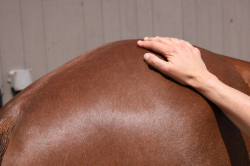 |
Solution: The new saddle was balanced
and had plenty of room so that it was not pinching the back.
I identified the tight gluteal muscles as the cause of the motion
problem. Using compressions, one of the Wilson Meagher Sportsmassage
techniques, I worked on both gluteal muscles of both hind legs
with a particular focus on where the gluteal muscle lies near
the croup or sacrum. Compressions are used to spread the tight
muscle fibers. When a muscle is tight, the fibers of the muscle
lie too close together, restricting movement and blood flow.
I used a soft, open hand, with the heel of my hand, to perform
compressions spreading the muscle fibers, and loosening the
entire gluteals.
|
| |
|
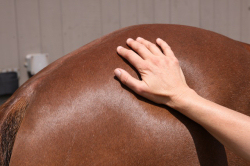 |
The compressions are a rhythmical pumping action similar
to CPR (cardio pulmonary resuscitation). I then used compressions
and worked on the entire horse from neck to hamstrings, focusing
on the lower back. The horse is a unit and he must function
like a unit. Therefore when working on the effected muscles,
the entire horse must be worked on so that he is not out of
balance. Remember, if one muscle is tight, then other muscles
will be tight in compensation for the primary tight muscle.
|
| |
|
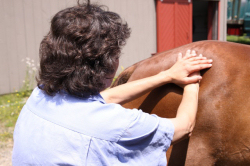 |
Once the gluteal muscles were loosened, the lower back got
looser. I then suggested that Jane ride the horse in a connected
frame at the canter. The canter is the most concerted exercise
at lengthening all the major muscle groups. I told her she did
not have to canter very long, just simply twice around the arena
in both directions, enough to further lengthen the muscles that
I just worked on. The exercise becomes part of the treatment.
This is sportsmassage. It prepares the horse to be used. The
canter also lengthens the back muscle really well. That is why
the trot is always better after the canter. |
|
|
